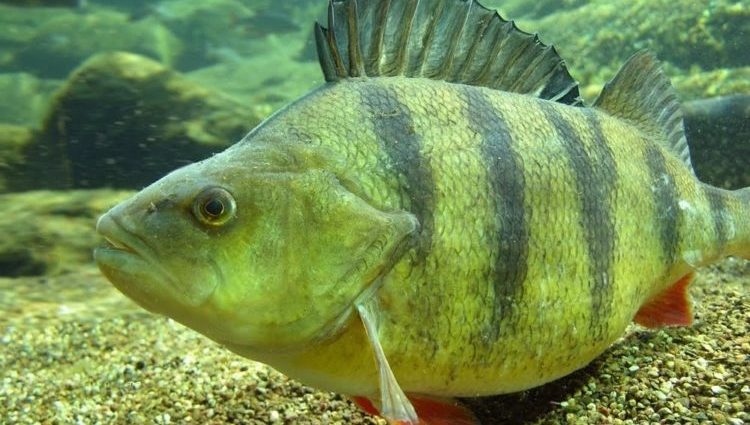Contents
Perhaps the most common predator living in the country’s inland waters is perch. The striped brethren inhabits almost any water area. “Sailors” of various sizes are found in large rivers and reservoirs, tributaries, lakes, private ponds and fisheries, streams and swamps. Contrary to the generally accepted opinion about the simplicity of catching a striped robber, it is not possible to get it with tangible ease everywhere. Weak activity and ignoring fishing baits are associated with a small number of fish in water bodies, an abundant food supply, and high pressure.
Perch and its habits
The striped robber is a pack predator. Perch cannot be attributed to ambush fish, such as pike, it is more relaxed, it occupies both areas with shelters and free zones. Throughout life, the fish can fight off the flock. As a rule, this occurs already in adults. With a set of masses, the flock becomes smaller. The largest specimens can live alone, clinging to groups of “striped” only during spawning.
Perch spawning occurs immediately after pike spawning, so this species can be called early in this event. When the water temperature reaches 8 ℃, the fish begins to move towards shallow waters, grassy waterings and snags. On average, spawning occurs in mid-late March, but the time may shift from year to year, depending on the approach of spring and water temperature.
Many anglers note the high activity of the predator in front of the spawner. At the end of February, you can get on excellent fishing if the water area retains its transparency. In muddy water, the striped robber bites poorly, but it comes close to the shores, where it is easier to find it with delicate gear. After spawning, the fish “sick”, completely refusing to feed. She needs to be given a few weeks to recuperate and start eating.
The perch diet includes:
- fry, including own juveniles;
- caviar of white and predatory fish;
- benthic invertebrates;
- leeches, tadpoles;
- insects and their larvae.
A small predator feeds exclusively on “meat” food, however, it can fall on vegetable baits by pure chance. In catching perch, the movement of the nozzle is important, whether it be a wobbler, a spinner or a red worm. You can also catch fish on the dough if you put it on an active mormyshka.
The average size of prey depends on the size of the reservoir, food supply and pressure from anglers. In early spring and autumn, larger specimens come across, in summer a small perch pecks. The “sporting” size of a predator is 30-70 g, individuals over 300 g are considered large fish, and “humpback” weighing more than 500 g can be called trophies.

Photo: klike.net
Under optimal conditions for life, perch can reach a weight of more than 3 kg. Such a large predator is practically inedible, it is better to give life to a seasoned inhabitant of the reservoir, which will contribute to the production of offspring.
The perch is famous for its high fecundity and the larger the female, the higher its value for the reservoir. With age, females begin to predominate in the livestock. 100% of large individuals account for only 5-10% of males.
Predator search tactics
For many years of fishing practice, a huge number of fishing methods and lures for fishing “striped” have been invented and developed. However, the search for fish does not depend much on the chosen method of fishing, you can build on the type of fishing, choosing a more comfortable place for fishing from promising areas.
The perch stays in relatively shallow water:
- at the coastal edges;
- on the upper steps of the dumps;
- under the steep banks;
- not far from the wall of cattail, reeds;
- in bays, upper reaches of lakes and ponds;
- under the water lily and near the snags.
It is not difficult to find a promising place on any reservoir: first, they check the coastal zones, examining the coastal vegetation, then, they switch to studying the relief.
Fish select parking according to several principles:
- availability of food base;
- uneven terrain;
- weak current or its absence;
- large or many small shelters.
The striped robber is always near a flock of bleak and other fry. He can safely swim below the location of the flock, leaving for feeding at certain hours. The striped brethren do not like a strong current, but can be present on a section of the river with a jet, arranging parking close to the shore, where the water is relatively calm.

Photo: spinningpro.ru
Blocks of trees, snags sticking out of the water, vegetation – all visible shelters can serve as a beacon for a striped robber. As a rule, he does not use them as a means to hide. Driftwood and fallen trees attract a predator with an abundance of insects, larvae and mollusks that settle on branches. Large “striped” is often found on the shell rock, as it can eat the meat of bivalve mollusks – barley, toothless and freshwater mussels.
The perch stays in the same places all season long, leaving the habitable zones only during the flood period. At this time, the predator goes to spawn, looks for quieter areas for spawning, enters bays, and visits river floods.
How and what to catch perch
This small fish for many lovers of outdoor recreation has become the first trophy caught on spinning or float fishing rods. The striped robber is equally effectively caught on both artificial and live baits. The choice of fishing method should be based on the characteristics of the chosen place and the vagaries of the fish. When a predator is passive, it is better to catch it on live bait, such as a worm or live bait. It happens that a perch seen near the edge does not take artificial silicone, ignores the wobbler and the turntable, but picks up the worm served on the hook from the ground. Thus, it can be caught immediately after spawning, using a spaced mounting and a natural bait. Many spinners always take animal bait with them if they suddenly fail to get away from zero in the usual way.
Spinning and edible silicone
Spinning fishing is a classic form of catching predatory fish. Many experienced spinningists complained 10-15 years ago that on small rivers the perch is too capricious and refuses any baits supplied. If already proven turntables worked perfectly on stagnant reservoirs, then on small rivers they did not bring results.
The turning point was the popularization of microjigging, after which the perch still managed to be caught. It turned out that the striped predator on small rivers is more fastidious and requires the use of the most delicate gear, lures and leads. Miniature worms, 2-4 cm in size on shipment from 1 to 3 g, have become classics for catching river “minke whales”. At the same time, both small specimens and really trophy individuals came across on the hook.
To catch perch on silicone, you will need an ultra-light rod with a test of up to 7-8 g. It is important to choose a solid type model with a soft glued tip. With the help of such spinning, you can use any animation and watch the lightest bites.
In addition to the perch rod test, other characteristics are also important:
- system;
- length;
- letterhead and pen material;
- handle type;
- reliability of the reel seat;
- the number and placement of throughput rings.
The structure of the “stick” for microjigging should correspond to the baits used. The ultra-fast and fast type of rod is preferred because this blank has a bend point closer to the last quarter of the spin. Sensitive tip allows you to feel the bottom with a light bait.
According to the laws of physics, long perch “sticks” tend to break when casting or playing fish. The optimal growth of rods with a test of up to 8 g is 1,8-2,2 m. The material for the blank is graphite and the higher its modularity, the more expensive the rod is. Graphite or carbon fiber is a lightweight, flexible and durable material that does not tolerate careless handling. In the hands of such a spinning turns into the most sensitive weapon, however, with inept use or transportation, it can quickly chip or shatter into small parts. For beginner anglers, cheaper low modulus graphite options are recommended, which forgive beginner mistakes.
For light spinning tackle, it is important to keep the minimum weight and high comfort of use, so the fishing market is dominated by models with a spaced handle. Cork wood is one of the main butt materials, but it does not look as presentable as modern polymers such as EVA. Ultralight blanks have many rings placed on the rod. With their help, the load from the resistance of the fish is distributed evenly.
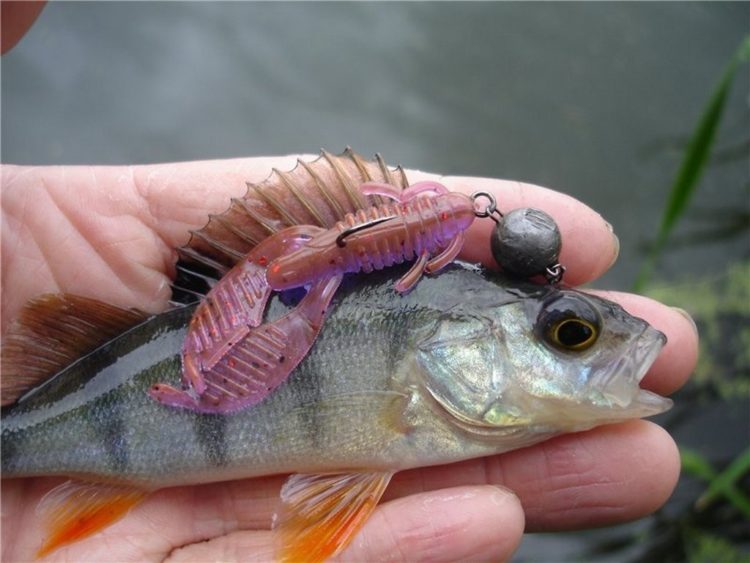
Photo: activefisher.net
For fishing, low-profile spinning reels with a spool size of 1000-1500 units are also used. The thickness of the cord is from 0,06 to 0,1 mm, the color is selected brighter so that the braid can be seen on dark water. Many bites can only be identified by the movement of the line, so pink and canary shades are the most in demand. There must be a leash between the bait and the cord. The material is either fluorocarbon of a thicker diameter, or a rigid fishing line. The leash allows you to keep the bait when meeting with the teeth of a pike, and also takes on the contact with the abrasive surface of stones, branches or shells.
Passive models are popular among baits:
- arrange;
- worms;
- crayfish;
- insects;
- larvae
This type of bait is used by more experienced anglers. Silicone products in this category do not have their own game, so they are animated using rod, reel or cord movements.
There is also an active class of nozzles:
- twisters;
- vibro tails;
- crayfish with active claws;
- double tweeters.
These models are not inferior in catchability to the previous category, however, they are used in high perch activity, as well as in the search for fish. Even a beginner can fish with active bait, it is enough to turn the reel and follow the tip of the rod.
For fishing on silicone, several types of postings are used:
- single or double toss;
- high broach rod;
- dribbling at the bottom or in the water column;
- lure dragging;
- combined wiring.
Appropriate leads work best for active fish. Wide-step tossing allows you to quickly find a predator, this type of animation is recommended for use in summer. In autumn and winter, as well as in early spring, dragging can work, but dribbling is considered the main drive. High rises of the bait in the thickness allows you to explore the entire vertical of the water column, because the perch often stands higher, especially when the water is warm and there are a lot of fry around.
Mandulas and foam fish
Silicone is not the only bait that catches the striped robber from the bottom. Mandula is a classic polyurethane lure with unique properties. The floating material behaves well at the bottom, becomes vertical, which makes it easy for the fish to pick up the bait.
Mandulas can be made up of many elements. For perch fishing, small models consisting of several parts are used. The bait is equipped with a triple hook, which perfectly detects a predator, but also clings to obstacles. The best place to use the mandala is a sandy slope, where the striped robber likes to hang out.
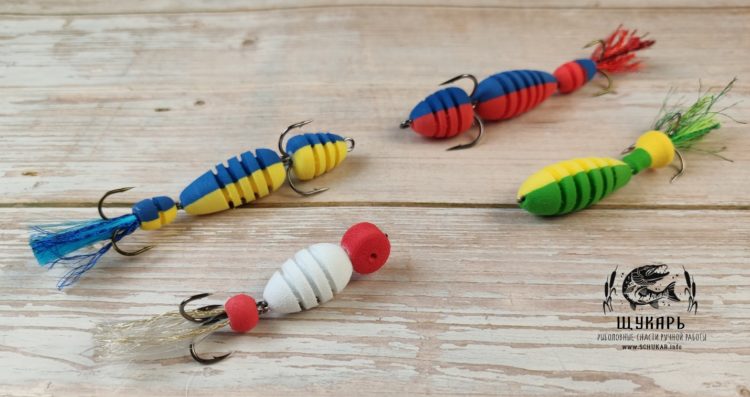
The wiring of the mandula is somewhat reminiscent of catching on silicone. Here you can use the classic jig techniques with touching the bottom. The length of the pauses depends on the activity of the fish. If the perch is passive, the duration of the stops should be increased. Mandula plays beautifully in the current. When touching the bottom, the body remains in a vertical position, slightly swaying from the flow of water.
We offer to purchase sets of author’s handmade mandulas in our online store. A wide range of shapes and colors allows you to choose the right bait for any predatory fish and season.
GO TO THE SHOP
Foam rubber fish also have a number of advantages:
- The foam retains air bubbles and releases them during wiring.
- The material is buoyant, so it also stands upright on the bottom.
- The soft structure allows you to hide the hooks in the body.
- The foam perfectly imitates the texture of real prey, and the perch does not release it immediately.
At times, foam rubber brings excellent catches, but its use requires experience and own experience.
Wobblers for perch
Both active and passive striped predators are perfectly caught on a certain type of wobbler. Fish are caught on any bait, however, targeted fishing requires the selection of the most effective products.
A wobbler for perch should have a number of characteristics:
- maximum body length – 5 cm;
- the shape of the bait is krenk, fet and minnow;
- deepening within 0,5-2 m;
- color from natural to acid tones;
- game on twitch and on monotonous animation.
Lures with a range of sizes from 2 to 5 cm are suitable for fishing. Perch can be caught on larger sizes, but bites will be noticeably less. In addition to cranks, minnows and fetas with amplitude play, you can use amphipods – wobblers with a body curved to the side. They imitate a wounded fish and perfectly seduce a perch.
Depending on the season and depth in the fishing area, lures with a certain working horizon are selected. In summer, models with a small spatula show good results, in autumn – dip products.
The color of the nozzle is selected according to the criteria:
- season;
- time of day;
- weather
- water transparency;
- fish activity.
If fishing is carried out in the summer, and the water blooms a little, bright colors are used. The same applies to spring, when the water has poor visibility. In autumn, matte tones, greens, olives and browns work best in crystal clear waters.
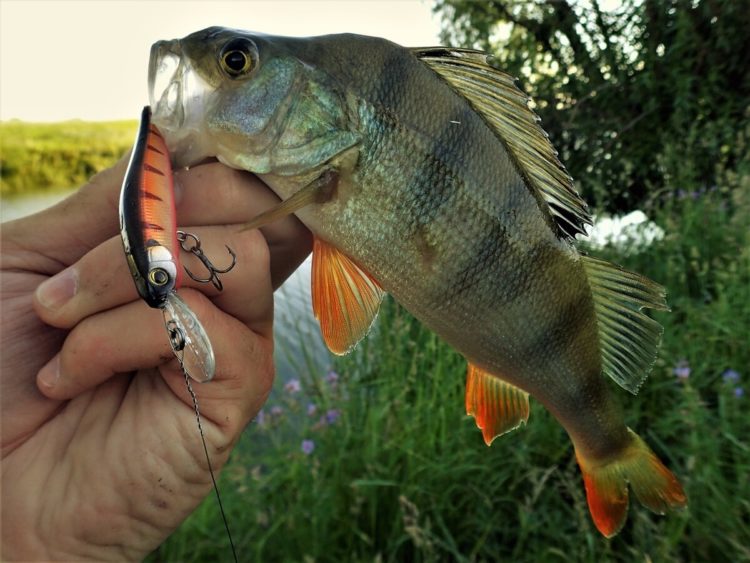
On fishing counters you can also find bladeless wobblers working on the surface. These include: walkers, poppers, chuggers, proppers, etc. All of them are able to attract fish, especially in the summer, when they are most active near the surface. Lures without a blade are the best solution for fishing in “cauldrons”.
Spinners and turntables
In the spring, when the water is highly turbid, many anglers switch to small oscillating and spinning lures. The size of the oscillators should not exceed 5 cm, the size of the turntables used is “00”, “0”, “1”, “2”. In summer, when the fish are more active, size “3” can be used.
Unfortunately, these types of baits do not work on all water bodies. Both types of spinners imitate fry, emitting a sheen similar to scales. Wide-bodied clothes equipped with a large single or small tee are popular among oscillators.
The color range of spinners is incalculable. Among the popular and catchy models are metallic shades (silver, gold, brass and copper), natural colors (black with dots, olive, brown, blue), as well as bright colors (orange, red, yellow, light green, etc.) .
The choice of the color of the spoon depends both on the conditions in the reservoir and on the activity of the fish. A more hungry perch responds to provocative colors, a passive fish reacts to natural tones.
Spinners are more often used when fishing from a boat. They serve as an excellent weapon for finding a predator in large water bodies: rivers and reservoirs, lakes. The emitted shine can be seen from afar, so metal spinners are one of the best as search attachments.
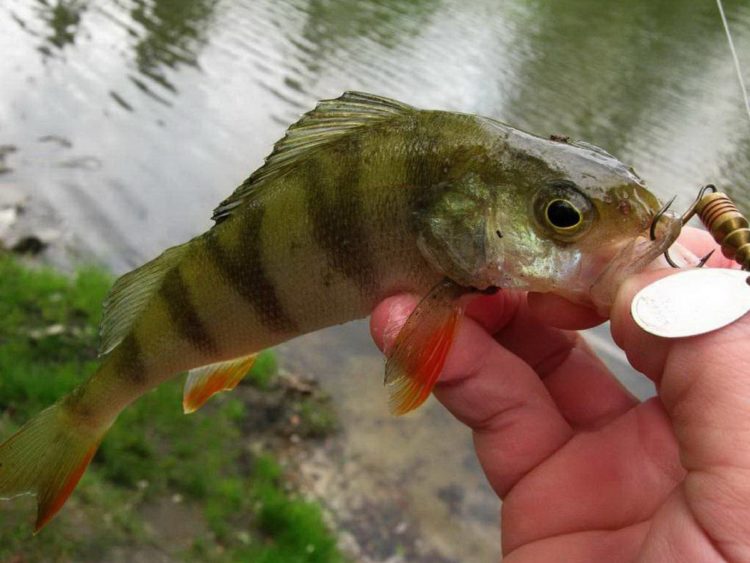
Monotonous game works on the perch medium. If the fish is active, then there is no need to “reinvent the wheel”, this animation is quite enough to ensure the catch. In other situations, you can use effective techniques that incite the fish and provoke it to attack:
- slight twitches;
- stops;
- wiring acceleration;
- slowing down and filling up the spinner.
All of these techniques work great on both oscillators and turntables. Any failure in the rhythmic play of the spinner provokes the perch to attack. It happens that the flock pursues the bait, but does not dare to pick it up. A slight stop or twitch can coax a capricious predator.
Float and feeder, live bait fishing
Spinning attracts a lot of anglers, but there are those who prefer stationary fishing to active fishing. A bobber and feeder are excellent tools for catching banded robber.
For fishing, they use a rod with a length of 4 to 6 m. Budget models have a large mass and it is almost impossible to catch them with your hand. For perch, both max and lap dog are used, depending on the preferences of the angler. Fly tackle does not have a reel, and since medium-sized fish are more often caught on the hook, it remains a priority.
For fishing, a simple equipment is used, consisting of several parts:
- sports float;
- retainer;
- a cascade of particles;
- hook with a long shank.
When fishing, the float should go deep to the waterline if fishing is carried out in the thickness. As a rule, it is located at the intersection of the last two colors of the tip. In this position, the signaling device is able to show a bite both on the rise and in depth. The perch often drowns the float, so the signaling device should be carefully monitored.
The nozzle is:
- red and earthworm;
- large bloodworm;
- maggot, including pink;
- creep pieces;
- grasshopper and other insects.
The perch is perfectly caught on any insect or its larva. It is important that the nozzle remains alive underwater and moves a little. Passive fish feed only from the bottom, an active predator picks up the bait both in the bottom layer and in mid-water.
The perch has a large mouth and often swallows the hook deeply. Special tools such as an extractor and a surgical clamp will allow you to quickly release the caught prey.
In addition to insects and worms, live bait can be used. Small bleak, rudd and mustard are taken as bait. You can also use roach and crucian carp, in a word, everything that you managed to get. For fishing, they take a more powerful float that the fry will not sink, as well as a hook of the appropriate size. The fish is hooked to the back or lip. A single cut is much better than doubles or trebles.
The live bait often catches a larger perch, the nozzle helps out where the striped robber bites badly on artificial baits. As a float, you can use a small bombard, it is transparent and does not scare away the fish.
Feeder tackle is another example of how you can catch a sailor. In large water bodies, fish can live far from the coast and it will be possible to get it only with the help of gear with an inertialess reel.
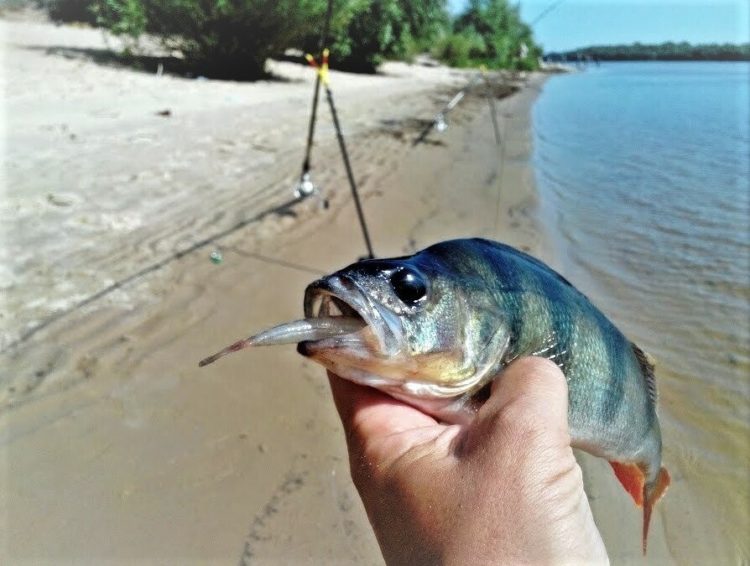
Photo: activefisher.net
Nozzles for the feeder do not differ from float baits, only live bait is not used for long-distance casting. A small fish does not tolerate a blow to the water, losing its attractiveness to predatory fish.
The feeder allows you to catch at a long distance, where there are dumps, shell rock, depth differences and snags. If there was no boat and a box with silicone at hand, then the English donka is able to fully replace active fishing with artificial lures.
Perch can be lured with clay and chopped worm. This mixture, enriched with animal feed, is slaughtered in a feeder and thrown onto a point. It is important that the clay is crumbly and easily washed out at the bottom.
An alternative option for tackle on live bait is an elastic band. It allows you to deliver the bait safe and sound to distant promising areas. Elastic band is a classic tackle for catching white fish and predators. 5 hooks, located a meter apart, cover a large fishing area, so the effectiveness of the equipment is at a high level. Tackle is installed using a boat, swimming or casting along the reeds and cattail. The same fry serves as a nozzle, you can use a red and earthworm.
Ice fishing for perch
If a predator is perfectly caught in open water, then it bites even better from ice. Perch is the most popular winter fishing target as the fish tend to form large schools and are easy to spot. From the ice, perch are caught in almost any frozen body of water. With a cold snap, the food base becomes scarce, and a large population of striped robbers must eat something.
There are days when the predator does not bite almost at all, however, even in such unfavorable conditions, it is possible to catch several tails.
In winter, the perch does not leave their homes, feeding on fry and bloodworms. Striped robbers react to movement in the water and pick up any food that is edible for them.
Mormyshka
Perhaps the most popular bait for fishing for perch is fishing for mormyshka. A small brass, lead or tungsten bait works great in combination with a bloodworm, and no-bait models are also known that have a high vibration amplitude, due to which they attract fish.
Effective jigs for perch:
- rounded and faceted shot;
- ant and oatmeal;
- maggot, howler;
- hoof, drop;
- chertik, nail-cubic.
Tackle for catching mormyshka should be light and not burden the brush. Fishing is active, search, so a drill with sharpened knives or a pick should be in the arsenal. A drill diameter of 80-100 mm is quite enough for catching fish up to half a kilogram.
The most popular sport-type rod is the balalaika. It has a small whip and a closed reel. A short nod allows you to make quick swings, which are tempted by the fish. The diameter of the fishing line ranges from 0,08-0,1 mm. Many experienced anglers can use soft 0,06mm nylon and an almost weightless lure when looking for passive fish.
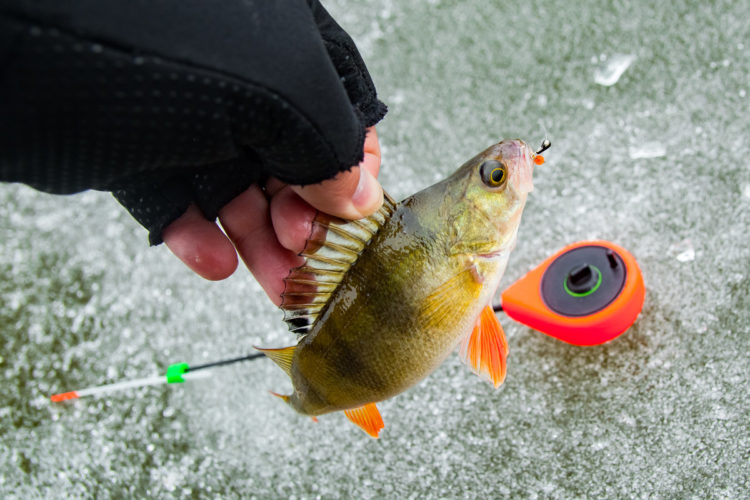
Photo: activefisher.net
The search for perch is carried out along the coastal edges, not far from the wall of reeds and other vegetation, near any obstacles visible to the naked eye. Most often, the fish keeps at depths from 0,5 to 3 m, however, in some places perch is also found en masse in pits up to 5 m.
Balancers, sheer spinners and rattlins
No-bait baits include not only mormyshkas. Small vertical baubles, balancers and bladeless rattlins of the sinking type are all used for fishing on the “striped”.
Spinners can be with a hanging tee or a single hook soldered into the body. The game is different depending on the type of hitch. Small baubles in 90% of cases have a metallic color. On a sunny day, copper and silver lures are used; on cloudy days, brass and gold are used.
For fishing on sheer nozzles, a specialized winter rod equipped with an inertial reel is used. A small rather hard nod signals a bite or touching the bottom with the bait.
When catching, they use tossing with pauses, dribbling in the thickness, hitting the bottom and hanging. All tricks take place if they are correctly implemented in animation.
Balancers are unique baits with a wide range of play. To search for perch, balancers can be considered a standard, since the nozzle covers a wide area and is visible from afar. Balancers are ineffective when fishing in snags and vegetation, since they have a high degree of hooking.
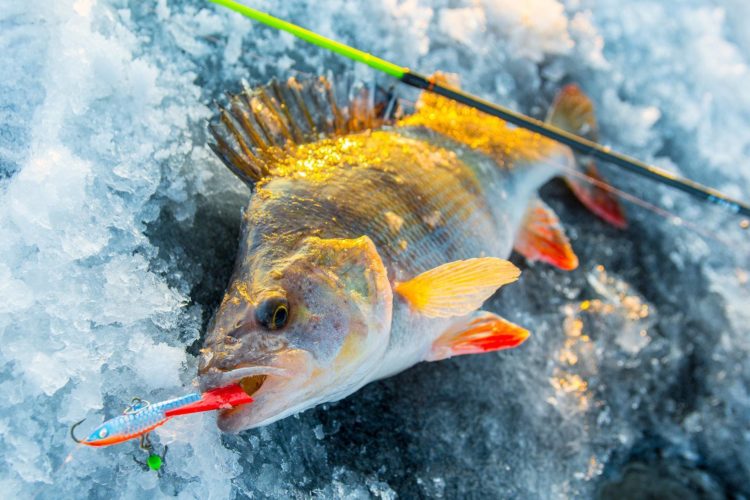
Photo: activefisher.net
Due to the plastic tail, the lure plays a figure eight, repeating somersaults when swinging. The most important detail of the balancer is the colored drop on the tee, which draws the attention of the predator. Without it, the perch hits inaccurately and the number of idle bites increases by 3-5 times. Some anglers bite off single hooks with pliers, leaving only the tee.
Rattlins are baits that can lure large fish. They also take up a vertical position, although they can be slightly tilted down with one of the parts, depending on where the mounting eye is.
Rattlins have a bright game, but they do not leave the fishing zone as far as balancers. Rattlins are used on rivers and large reservoirs, where it is necessary to cut off small things and catch a large “humpback”. Among the baits come across quiet models and products with an internal capsule. The additional sound works great on an active perch, but can scare off a striped robber in the wilderness. Pike are often caught on rattlin, so it should be used with a small leash so as not to lose the bait in case of a “toothy” approach.










